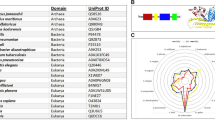Abstract
The nucleotide sequence of a genomic fragment from Halobacterium salinarium containing an open reading frame encoding a protein with a calculated molecular mass of 71 kDa was determined. Database searches revealed that this protein, Hp71, has similarities to eukaryotic cytoskeletal proteins. Heterologous production of Hp71 in Escherichia coli allowed the isolation of anti-Hp71 antibodies. The antibodies were used (1) to verify the production of Hp71 in H. salinarium and (2) to determine its cytoplasmic localization by immune electron microscopy. Homologous overproduction of Hp71 in H. salinarium and heterologous production in Haloferax volcanii resulted in modifications of cell morphology from rods to extended rods, and from pleiomorphic cells to rods, respectively. Structure prediction methods indicated that Hp71 has a head-rod-tail configuration, including an N-terminal domain with a nucleotide binding motif (P-loop), and an extended discontinuous coiled-coil domain of 330 amino acids. To identify related proteins, the complete genomes of Haemophilus influenzae, Mycoplasma genitalium, and Methanococcus jannaschii were searched for deduced proteins with extended coiled-coil domains. Only one or two proteins were found for each organism, showing that Hp71 is one of only a few prokaryotic intracellular proteins with extended coiled-coil domains. The phenotype upon overproduction and the similarity of Hp71 to the SMC superfamily of P-loop head-rod-tail proteins (named after SMC1, which is involved in the “stability of minichromosomes” in yeast) indicate that Hp71 might be involved in cytoskeleton formation and/or chromosome partitioning in H. salinarium.
Similar content being viewed by others
Author information
Authors and Affiliations
Additional information
Received: 25 March 1997 / Accepted: 11 August 1997
Rights and permissions
About this article
Cite this article
Ruepp, A., Wanner, G. & Soppa, J. A 71-kDa protein from Halobacterium salinarium belongs to a ubiquitous P-loop ATPase superfamily with head-rod-tail structure. Arch Microbiol 169, 1–9 (1997). https://doi.org/10.1007/s002030050534
Issue Date:
DOI: https://doi.org/10.1007/s002030050534




